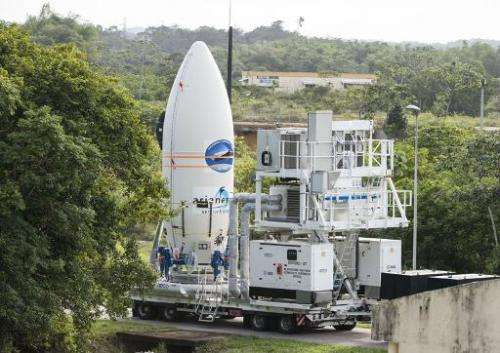Europe tests space plane in step to strategic goal

Europe on Wednesday said it successfully launched and brought back to Earth a prototype space plane in a strategy to join an elite club of space powers.
In a 100-minute operation, the European Space Agency (ESA) took a wedge-shaped wingless robot craft on a sub-orbital flight to test re-entry technologies.
It marks the first step in an effort to emulate the United States, Russia and China in mastering the skill of not just launching a spacecraft but also bringing it home intact.
"The mission has come to an end according to plan... it couldn't have been better," ESA Director General Jean-Jacques Dordain said in a live webcast.
Mission officials cheered and hugged after the car-sized craft splashed down on schedule in the Pacific.
Programme chief Giorgio Tumino told AFP the operation had been a "100-percent success."
"Europe has demonstrated it has the technological grounds to perform return-from-orbit missions," Tumino said. "It's a very big day for Europe."
Dubbed the Intermediate eXperimental Vehicle (IXV), the craft aims at filling a gap in Europe's range of space abilities.
ESA has notched up glittering successes in unmanned missions, from Earth-observation satellites and the Mars and Venus Express orbiters to the comet-chasing probe Rosetta.
But until now, its spacecraft have been one-way affairs.
They are either sent out into the Solar System, never to return.
Or they are deliberately destroyed at the end of their mission in a suicide plunge, burning up in the fiery heat of atmospheric re-entry.
Nor does ESA have its own capacity for human flight—European astronauts instead have been taken aloft and returned to Earth aboard the US space shuttle or Russia's Soyuz.
"Mastering re-entry will open a new chapter," ESA said.
"Such a capability is a cornerstone for reusable launcher stages, sample return from other planets and crew return from space, as well as for future Earth observation, micro-gravity research, satellite servicing and disposal missions."
The IXV design seeks to strike a balance between flat-bottomed capsules—the tried-and-trusted return-to-Earth vehicle since the pioneering days of space—and the US shuttle, a winged but complex and expensive system, two of which were lost before the craft was retired.
Five metres (16 feet) long and two tonnes in weight, it looks like a wedge whose surfaces have been slightly rounded, providing lift but less resistance than wings to atmospheric molecules.
Manoeuvrability in space comes from four thrusters, while two hind steering flaps are intended to stabilise and angle the craft for its return path. Ceramic panels shield it from temperatures up to 1,700 degrees Celsius (3,092 degrees Fahrenheit).
The research mission saw the IXV, stuffed with sensors and cameras, launched by a lightweight Vega rocket from ESA's base in French Guiana.
After separation, it ascended to an altitude of more than 400 kilometres (250 miles), headed eastwards and then descended to Earth at hypersonic speeds.
Slowed by parachutes, it splashed down about 3,000 km west of the Galapagos Island.
Discover the latest in science, tech, and space with over 100,000 subscribers who rely on Phys.org for daily insights. Sign up for our free newsletter and get updates on breakthroughs, innovations, and research that matter—daily or weekly.
Data haul
With flotation balloons providing buoyancy, the IXV was to be picked up by crane by a recovery ship and then transferred to ESA's technical centre in the Netherlands for post-mission scrutiny.
"The data analysis part of the work is to begin soon," Dordain said.
"It will be hard work, but it will move the frontiers of knowledge further back concerning aerodynamics, thermal issues, guidance and navigation."
The prototype brought together 40 companies, universities, researchers and institutes in 10 countries under an Italian-led programme.
It cost 170 million euros (192 million dollars) plus 40 million euros in launch costs, according to French officials.
The next mooted step is to build a robot space plane called PRIDE—"Programme for Reusable In-orbit Demonstrator for Europe"—that could land automatically on a runway after its mission.
PRIDE "will be similar to but smaller and cheaper than" the X-37B, ESA says, referring to a secretive Pentagon unmanned mini-shuttle.
"But unlike the X-37B, (it) would be managed under civil auspices."
© 2015 AFP



















